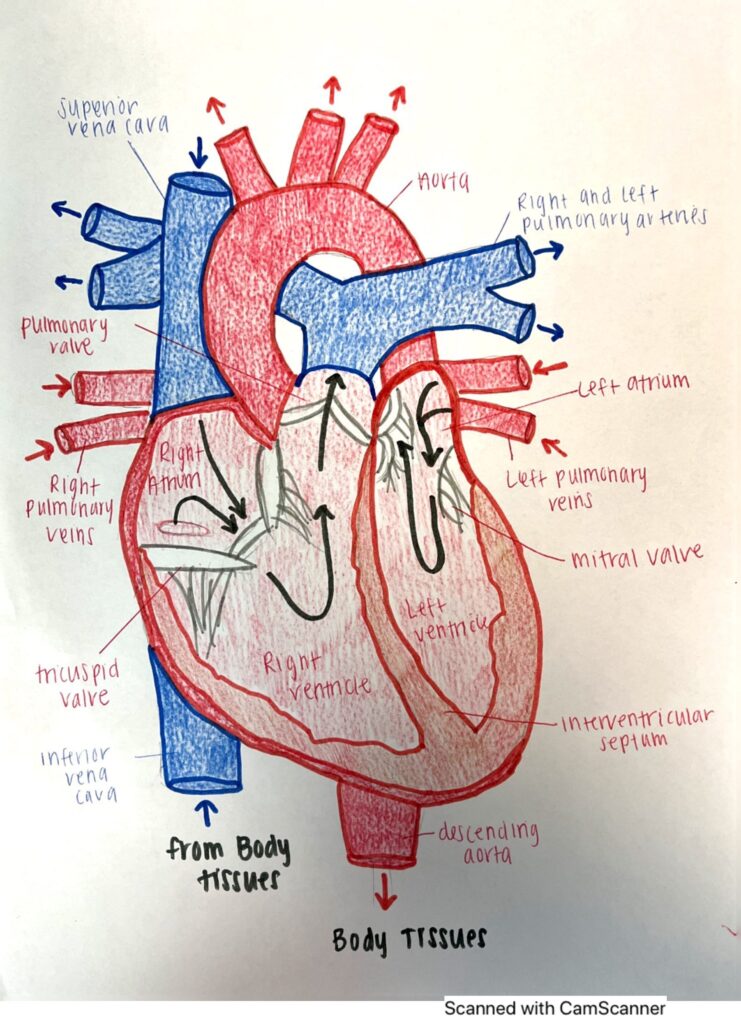In the body, there is a specific way that blood flows to ensure that all the tissues receive oxygenated blood. There are two circuits in the body that transport blood throughout. These circuits are the systemic circuit and the pulmonary circuit. The systemic circuit consists of the blood that travels to the tissues, and then back to the heart. The pulmonary circuit consists of the blood that is carried from the heart to the lungs for gas exchange and then back to the heart to be transported out into the systemic circulation. In the systemic circuit, the veins have little oxygen, since the oxygen was just delivered to the cells. In the pulmonary circuit, the arteries carry blood low in oxygen, since they are carrying the blood to the lungs to become oxygenated. Arteries carry oxygenated blood away from the heart to the rest of the body and veins carry deoxygenated blood from the tissues back to the heart (Betty et al, 2017, pg. 827). The main objective is to understand the path of blood through the heart and the circulatory system.
There are four chambers in the heart which consist of two atria and two ventricles. The atria serve as receiving chambers and contract to push the blood into the ventricles. The ventricles are responsible for pumping blood to the lungs and the rest of the body. Blood flow begins in the right ventricle, where deoxygenated blood is pumped into the pulmonary trunk. This leads into the left and right pulmonary arteries heading towards the lungs. Arteries then branch out into pulmonary capillaries, where gas exchange occurs. Once the blood is oxygenated in the lungs, the pulmonary veins carry the oxygenated blood back into the left atria of the heart (Betty et al, 2017, pg. 827). There are four valves in the heart that are in each chamber to help keep the flow of blood going forward. These valves work to keep blood from flowing backwards and causing issues.
The left atrium of the heart pumps blood into the left ventricle, and the left ventricle pumps oxygenated blood into the aorta. Once the blood is in the aorta, it travels on to other arteries throughout the body. These vessels of oxygenated blood carry on until they reach the capillaries in body’s tissues and the gas is exchanged. Oxygen and nutrients are released from the blood and enter the cells to be used. Carbon dioxide and waste products are picked up by the blood to be transported so that they can be removed from the body (Betty et al, 2017, pg. 827).
Although the circulation of blood is an involuntary action, there can be some issues that arise with the flow of blood. Aneurysms are a well-known issue that arise from a weak area on the wall of an artery where a bulge forms (Aneurysm, 2022 ). A bulge can form in a weakened arterial wall due to the force of blood rushing through the vessel. Aneurysms can be dangerous if they rupture and can even lead to death (Aneurysm, 2022). Aneurysms can form in any artery of the body. Some examples of aneurysms include carotid aneurysm, thoracic aneurysm, cerebral and abdominal aortic aneurysm (AAA) (Aneurysm, 2022). The causes of aneurysms are not always clear, but there are some factors that increase you rrisk of having an aneurysm. For abdominal aortic aneurysms, your risk increases if you are over 60, if you smoke, or if you have hypertension (Aggarwal, Sourabh, et al). Aortic aneurysms are the 14th leading cause of death in the United States (Aggarwal, Sourabh, et al). The repair to fix an AAA comes with many risks. Once an aneurysm reaches a certain size, the risk of repair outweighs the risk of rupture (David, A. Vorp, et al). Issues with blood circulation in the body should be medically treated since they can cause detrimental effects.
Overall, the path of blood through the heart and the circulatory system is an important system to have in place. It ensures that all of our cells receive oxygenated blood so that they can survive and function properly. Issues with blood circulation, such as an aneurysm, are very serious medical concerns that should be evaluated.
References
Aggarwal, S., Qamar, A, Sharma, V. Sharma, A (2011). Abdominal AORTIC ANEURYSM: A Comprehensive Review. Experimental and Clinical Cardiology, U.S. National Library of Medicine, 16(1):11-15. https://www.ncbi.nlm.nih.gov/pmc/articles/PMC3076160/.
Aneurysm (2022). Cleveland Clinic. https://my.clevelandclinic.org/health/diseases/22769-aneurysm#:~:text=Aneurysms%20form%20when%20there’s%20a,clot%20can%20be%20life%2Dthreatening.
Betts, J. G., Desaix, P., Johnson, E., Johnson, J. E., Korol, O., Kruse, D., Poe, B., Wise, J., Womble, M. D., & Young, K. A. (2017). Anatomy & Physiology. OpenStax College, Rice University.
David, A. V. (2007). Biomechanics of Abdominal Aortic Aneurysm. Journal of Biomechanics, 40(9), 1997-1902. https://www.sciencedirect.com/science/article/abs/pii/S002192900600323X.

